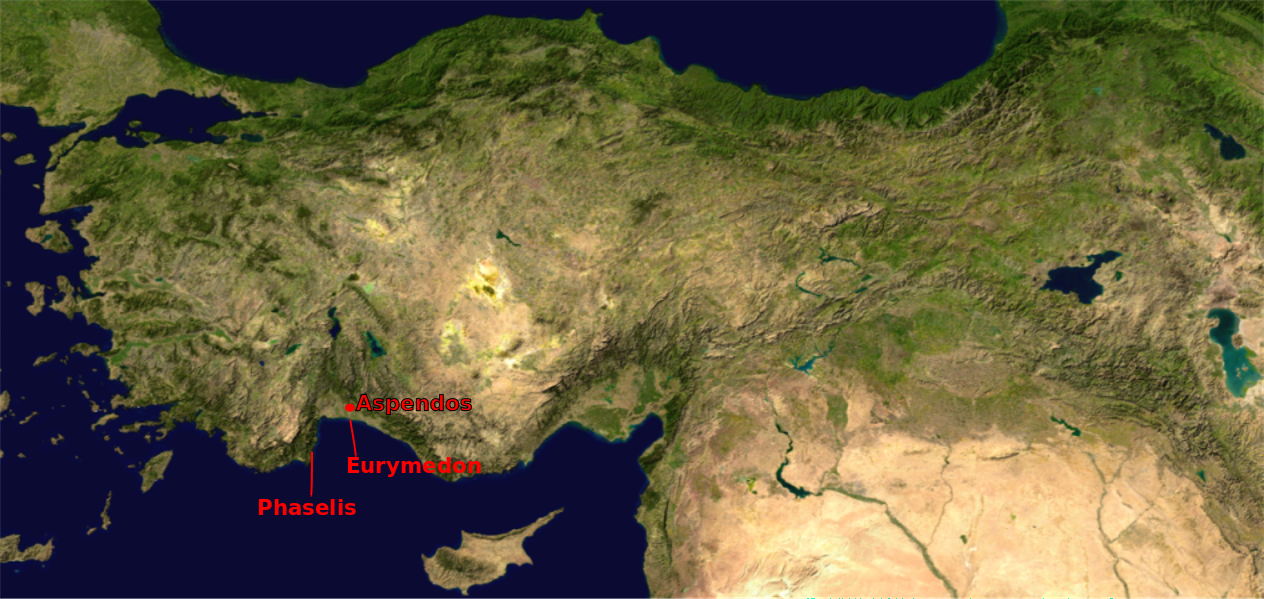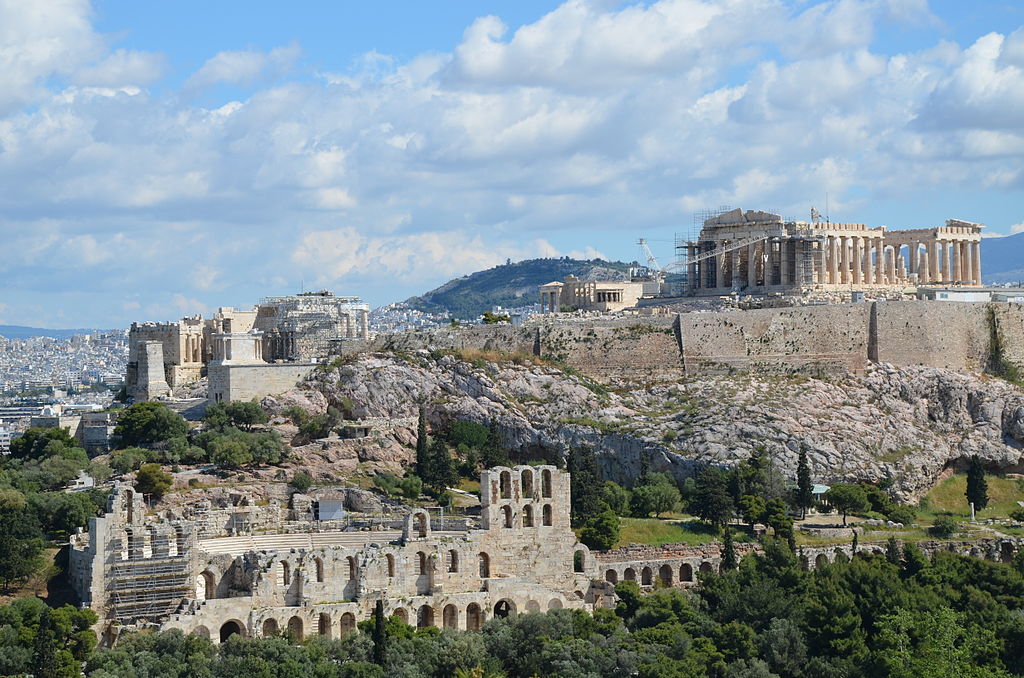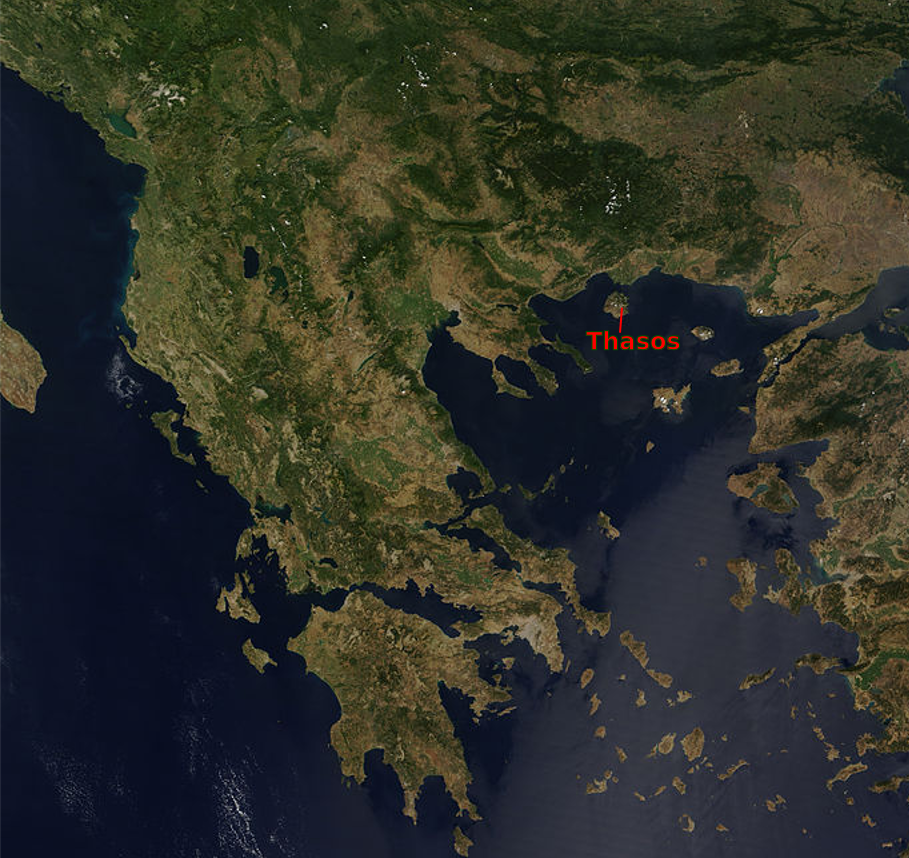The Battle of Eurymedon
After Eion, Skyros, and Naxos, the next mission for the Athenian Stratēgós Kimon came in either 469 or 466 BCE. After the siege of Skyros, he put in at the Piraeus. There he arranged for repairs and general supplies, and added more triremes to his fleet. The existing ships were designed by Themistoklēs with a focus on speed and maneuverability; the new design of Kimon had a wider beam and he put bridges between the decks. He increased the capacity for carrying hoplites, assuming this would make the ships more efficient in warfare.[1] He then sailed with a considerable fleet of two hundred triremes, and after Ionian contingents joined him, the number of the fleet increased to three hundred.[2] With this fleet he sailed from Knidos in Caria, with the aim of clearing the coasts of Asia Minor, from Ionia to Pamphylia, of Persian influence.[3]
Firstly, he sailed to Phaselis, a Hellenic city under Persian sovereignty, which maintained a flourishing trade network that included Naukratis in Egypt, Rhodes, Knidos, and Halicarnassus. Kimon assaulted their walls, after which the Chians, who were on friendly terms with the people of Phaselis, shot arrows over the walls with little messages attached with which they successfully convinced the people of Phaselis that they were not there to capture the city, but to liberate it.[4] The ships of Phaselis were then added to the fleet of Kimon. They agreed to “pay ten talents and join him in his expedition against the Barbarians.”[5]
Meanwhile, a large Persian armada lay at anchor at Aspendos, at the south coast of Asia Minor, near the mouth of the Eurymedon River, seemingly with the objective to move along the coast, capturing city after city with fleet and army moving together.[6] Two hundred Phoenician triremes were part of the Persian armada and another eighty Phoenician ships, sailing from Cyprus, were expected to join them. Not sure whether that would happen in time, the Persians firstly attempted to avoid a confrontation with the Greeks and put their ships into the mouth of the river, closer to the protection of the Medo-Persian land army.[7]

Within that same day, they attacked the Persian fleet that was afloat and overtook the persons that fled from the ships to the shore. After that, also the land-forces of the Persians, who marched threateningly down to the sea, were defeated, captured, and slaughtered.[8] The camp of the Persians appeared to be full of all sorts of treasure, by the sale of which the Athenians would be able to not only fund the expansion of the fleet, but also the construction of the southern wall of the Acropolis and the foundations of the long walls that connected Athens to Piraeus.[9] Creating funds for the walls and not for the temples, was in line with the sober, Spartan, approach for which the Laconophile Kimon was known.

The two hundred Phoenician triremes that were part of the Persian armada, would be either added to the Greek fleet or destroyed.[10] The eighty Phoenician triremes had put in at Hydrus, which possibly was the ancient close-by port city of Syedra. Without delay, Kimon’s fleet proceeded at high speed to Hydrus and destroyed most of the Phoenician ships.[11] Later, Perikles with fifty ships, and Ephialtes with only thirty ships, would sail beyond Cape Gelidonya and the five islands in front of it, ascertaining that now the complete area was cleared of Persian and Phoenician ships.[12]
The victory of the Delian League broke the Persian dominance in the waters between Cyprus and Asia Minor; the Aegean now became a Greek-dominated inland sea.[13] The cities of Caria and Lycia, including Knidos and Phaselis, joined the League.[14] The booty was used to finance the on-going reconstruction of the temples on the Acropolis of Athens, a city which was now a major power and the most important adversary of the Persian Empire. The chief commander of the Ionian allies was Aristides, who died shortly after the Battle of Eurymedon, in c. 468 BCE.[15]
Thasos
After the victory at Eurymedon, the focus of Kimon returned to the Chersonese, where certain Persians, supported by Thracians, rebelled against Athens. Kimon sailed out with four triremes only, a number that was sufficient for him to capture the fleet of thirteen Persian triremes and returned the Chersonese back to the control of Athens.[16]
In 465 BCE, a conflict arose between Athens and Thasos, an island in the Aegean Sea, just off the coast of Thrace. Thasos had traditionally mined on the Thracian mainland.[17] When Athens founded the colony Ennea Hodoi (“Nine Ways”) near the mouth of the Strymon River, Thasos saw her interests endangered and renounced her membership of the Delian League.[18] For support, they counted on the Spartans, but the timing was wrong; the Spartans suffered from the results of an earthquake which triggered a large helot revolution.[19]

Firstly, Kimon ended the naval power of the Thasians. He entered into a sea-fight and captured thirty-three of their ships.[20] At Ennea Hodoi, however, the Athenian colonists were defeated and driven off by local tribesmen. The support of these people and the hope of support by Sparta, may have contributed to the fact that it would take a siege of two years before the Thasians surrendered. They were then forced back into the league, their land, ships, and the mines of Thasos being confiscated by Athens.[21]
By attacking her ally, however, Athens had estranged herself from her partners in the Delian League. The Spartans were prevented from keeping their promise of intervention. Kimon, was expected to further invade Macedonia, although he would not consent to do it. Back in Athens, he had to defend himself against Perikles, but he would be acquitted for accepting bribes from Alexander I of Macedon.[22]
These events were the prologue to the transformation of the Delian league from an alliance of partners, into a hegemony, foreshadowing even the outbreak of the First Peloponnesian War.
Notes
1 Plutarch, The Life of Cimon 12.2.
2 Diodorus Siculus, The Library of History 11.60.3.
3 Plutarch, The Life of Cimon 12.2.
4 Plutarch, The Life of Cimon 12.3.
5 Plutarch, The Life of Cimon 12.4.
6 “They had six hundred ships, according to Phanodemus, and three hundred and fifty according to Ephorus. Whatever the number, nothing was achieved by them on the water which was worthy of such a force”. [Plutarch, The Life of Cimon 12.5]
7 The idea of the Greeks entering the mouth of the narrow river, gives an ironic word play with the meaning of the name “Eurymedon”, meaning “ruling far and wide”.
8 Diodorus Siculus, The Library of History 11.60–11.62.
9 Plutarch, The Life of Cimon 13.6–13.7.
10 Thucydides, The Peloponnesian War 1.100.
Plutarch The Life of Cimon 12.6.
11 Plutarch The Life of Cimon 13.3–13.4.
12 The five islands in front of this cape were called the “Khelidonia nēssoi” (Swallow Islands).
13 Diodorus Siculus, The Library of History 11.60–11.62.
14 Plutarch The Life of Cimon 12.3–12.4.
Thucydides, The Peloponnesian War 2.69.
15 William Smith Dictionary of Greek and Roman Biography and Mythology, London. entry on Aristeides.
16 Plutarch The Life of Cimon 14.1. This was 466 BCE according to Barnadotte Perrin’s footnote.
17 Thucydides, The Peloponnesian War 1.100.
Plutarch, The Life of Cimon 14.2.
18 The colony called Ennea Hodoi (“the nine ways”), would eventually become the site of Amphipolis.
19 Thucydides, The Peloponnesian War 1.100, 1.101.
20 Plutarch, The Life of Cimon 14.2.
21Thucydides, The Peloponnesian War 1.101.
22 Plutarch The Life of Cimon 14.2–15.1
Aristotle, Athenian Constitution 27.1.
Bibliography
Aristotle in 23 Volumes, Vol. 20, translated by H. Rackham. Cambridge, MA, Harvard University Press; London, William Heinemann Ltd. 1952. On Perseus:
http://www.perseus.tufts.edu/hopper/text?doc=Perseus%3Atext%3A1999.01.0046%3Achapter%3D27%3Asection%3D1
Barron J.P. 1972, “New light on old walls: the murals of the Theseion.” Journal of Hellenic Studies 92,1.9 20-45.
Diodorus Siculus. Diodorus of Sicily in Twelve Volumes with an English Translation by C. H. Oldfather. 1989. Vol. 4-8. Harvard University Press, Cambridge, Mass.; William Heinemann, Ltd. London. On Perseus:
http://www.perseus.tufts.edu/hopper/text?doc=Perseus%3Atext%3A1999.01.0084%3Abook%3D11%3Achapter%3D60
Plutarch. Plutarch’s Lives. With an English Translation by Bernadotte Perrin. 1914. Harvard University Press, Cambridge, Mass. 1959; William Heinemann, Ltd. London. On Perseus:
http://www.perseus.tufts.edu/hopper/text?doc=Perseus%3Atext%3A2008.01.0017%3Achapter%3D12%3Asection%3D2
Thucydides translated into English, with introduction, marginal analysis, notes, and indices. Volume 1. Thucydides. Translation Benjamin Jowett, 1881. Oxford. Clarendon Press. On Perseus:
http://www.perseus.tufts.edu/hopper/text?doc=Thuc.+1.100&fromdoc=Perseus%3Atext%3A1999.04.0105
Image credits
Figure 1: Satellite map of Asia Minor showing locations of Phraselis, Eurymedon, Aspendos
adapted from Anatolia composite map, NASA, public domain, via Wikimedia Commons,
non-commercial use permitted by NASA
Figure 2: The southern walls of the Acropolis. The Acropolis of Athens viewed from the Hill of the Muses. Author (photo): Carole Raddato from Frankfurt, Germany. Creactive Commons Attribution-Share Alike 2.0 Generic license, via Wikimedia Commons.
Figure 3: Satellite map of Greece showing location of Thasos
adapted from Satellite image of Greece, NASA, public domain, via Wikimedia Commons.
non-commercial use permitted by NASA
Featured image: Detail from Bust of Kimon at Larnaca, Cyprus.
Photo: Markus Leupold-Löwenthal. Creative Commons Attribution-Share Alike 3.0 Unported license, via Wikimedia Commons.
___
Rien is a member of Kosmos Society.